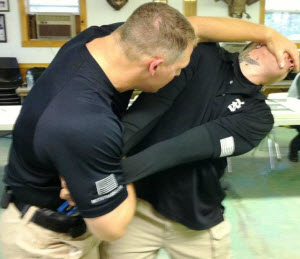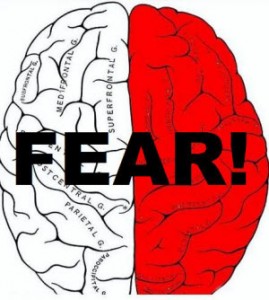“There is nothing to fear but fear itself.” – Franklin D. Roosevelt
Fear is always there, just under the surface, and can manifest in numerous ways. Some people are fearful of confrontation with a teacher, sibling, co-worker, spouse or unknown contact on the street. Others are fearful of change, such as changing jobs or moving to a new place. There are those who fear spiders and snakes, ghosts and sounds in the night, and some who fear the idea of being assaulted or the notion of falling victim to another. Fear can and has been used as a powerful tool of control by bullies, predators and terrorists. Our own fears can control us without our ever knowing how or why. In part one of The Combative Mindset, we discussed mindset and its importance in regard to living a defensive lifestyle. Here in part two, we will discuss fear, why it is so powerful, and how we can manage it in order to perform better at our given combative sports (martial arts, fitness, or shooting) and when protecting ourselves, family or others.
Internal and External Representation
How you think affects how you feel. How you feel affects what you do. And what you do affects the result you desire. Internal and external representations are how we think, feel, and form words and images inside our minds. This affects how we display ourselves outwardly to those in our environment. Fear very often begins with some type of internal dialogue or negative thought process such as: “What was that sound?”, “Did you see the size of that guy?”, “There are two of them!”, or “I can’t handle this.” If left unchecked, these common — albeit negative — internal thoughts will compound, leading to worse thoughts, anxiety and eventually full-blown panic, in which fear controls us.
Negative internal representation such as this and the resultant unchecked fear will be represented externally with downtrodden body language, negative attitude toward others and a timid demeanor. Street predators key on this body language and attitude, targeting those whom they consider easy prey. Half their battle is already won, since the target has already inwardly and often outwardly displayed an attitude of defeat and fear. Therefore, the foremost step toward proper fear management is to understand the significance our own internal thoughts and words have upon us. Manage your mind, thoughts, and choice of words and images in order to begin managing fear.
Generalized Combative Fear Types
Many types of fear exist and vary from individual to individual. In regard to combative mindset, we will focus on managing three types of fear: Performance Fear: Fear of poor performance at a given task, such as sparring, competitive fighting, pushing through physical barriers, or shooting.Fight Fear: Fear of interpersonal confrontation or instantaneous fear experienced during sudden attack or ambush.
Consequence Fear: Fear of loss of life (yours or someone else’s), loss of material objects, injury, pain or retribution after an altercation.

Unchecked fear can lead to panic. A strong perception of self value and positive internal communication can manage and counteract those feelings, spurring positive action.
Fear Management Techniques and Tactics
Expect It, Accept It and Override It
U.K.-based martial artist, author and filmmaker Geoff Thompson has been writing about and teaching others how to deal with fear for a long time. He advocates the expectation of fear: accept that fear will always be with us, understand what it is, and develop skills to override fear’s effects as essential first steps.
Self Perspective and Internal Communication
Instead of the negative thoughts discussed above, cultivate thoughts such as “I am too important to be taken away from my family,” “My family needs me,” “Too many people in my life need me,” “My team/partner needs me,” “I must win and persevere no matter what,” “I’m going to knock this guy out,” “I hit whatever I shoot at,” “These two guys don’t know what they are facing,” “I only shoot X rings.”
With this type of self perspective and internal communication, I am not concerned with what the opponent can do or the consequences of the event/confrontation, only with what I can and will do. This positive internal representation will be expressed externally via posture, body language and actions, sometimes resolving problems before they become critical. Confidence, calm, and a belief in one’s abilities are obvious in those who internally communicate with themselves in this manner. Develop a strong personal perspective and communicate positively with yourself if you want to dispel fear from your everyday life.
Understand the Difference Between Fear and Natural Physiology
Adrenaline stress is our natural biochemistry triggered into the bloodstream on recognition or perception that danger is present. We experience this same chemical response when going for a job interview or first approaching a member of the opposite sex we’re interested in. The differences are that the amount and how quickly the chemical response we receive are based upon our perception of the situation.
Signs of this chemical response include elevated heart rate, vocal quiver or change in tone, sweaty palms, nausea, narrowing of vision and, at higher levels, loss of fine motor skills. We are also less susceptible to pain and may experience increased strength. This chemical response can hurt us — if we let it — or help us. We have all felt that rush when startled or narrowly avoiding a traffic accident. What’s important is that recognition of this state only comes through experiencing it, and therefore it can and should be replicated during training.
Breathe
When startled, it is common to take a quick breath and hold that breath momentarily. During fearful situations and confrontations, this will happen and, combined with elevated heart rate, can lead to oxygen deficit in the brain. This in turn inhibits clear thinking and higher brain function. Remember to breathe: inhale deeply and exhale completely a couple of times whenever a feeling of fear or anxiety arises or after a sudden incident.

Good training allows you to experience fear and stress, build confidence, and desensitize the combative mind to the effects of fear.
Fitness Level
The better level of fitness one possesses, the more confident one can be in their ability to escape, fight back or endure punishment. Without this level of fitness, the internal message is one of doubt: “Can I run or get away fast enough?” or “Will I be able to climb over that fence?” This negative internal representation will reflect externally, thus affecting performance. Get in better shape, build confidence, and dispel self doubts and subsequent fear.
Experience and Training
Experience stress and fear to develop desensitization. This experience can safely come in the form of training. A good combatives or shooting program should include some fear, stress and a little confusion. This allows you to feel the natural biochemical effects of fear while developing skill proficiency. With proficiency comes confidence, the ultimate desensitization to performance fear.
Take Action
During a reactive critical incident, fear can be sudden, intense and possibly overwhelming. There will be no time to accept it and no time to breathe. This is when training kicks in. Immediate action — any action — is desirable in an effort to cut off the negative effects of fear and utilize the positive effects.
Conclusions
A critical element of combative mindset and preparation to defend ourselves and others is to understand what fear is and the natural physiological responses it has upon us. We must expect fear, accept it and learn to manage it before, during and after a confrontation. We all have varying fear thresholds: how quickly or easily we experience the effects of fear based on past experiences, confidence levels, training and/or perception of a situation.
It is vital that we understand where our personal fear threshold is prior to experiencing a critical incident, thus allowing development of techniques and tactics to manage that fear. Few possess the ability to live and operate with no fear, while everyone possesses the ability to know their fear and develop a strong combative mindset wherein fear knows its place.


Share tips, start a discussion or ask one of our experts or other students a question.
Already a member? Sign in
No Responses to “The Combative Mindset, Part 2: Fear Management”